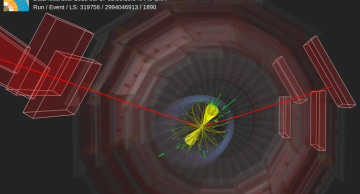In the world of elementary particles, there are twelve generic types of fermions (spin ½ particles): 3 up-type quarks, 3 down-type quarks, 3 charged leptons, and 3 neutrinos. They come in three generations. The number “3” is really a magic…
News
|
maiqbal |
Physics
Since the discovery of the Higgs boson in 2012, scientists have been on an epic quest to measure its properties and hunt for any clues that might reveal new physics beyond the Standard Model (SM). One of the main studies consists of counting…
|
ajafari |
Physics
The CMS Collaboration at CERN has conducted an analysis to explore the differences between tau leptons and muons, the two heavier cousins of the electron, and both also fundamental particles in the Standard Model (SM) of particle physics.…
|
ajafari |
Physics
The term "Dark Matter" was coined in 1933 by Fritz Zwicky. While studying the Coma galaxy cluster, he observed that the galaxies were moving too fast to be bound by the visible mass alone. He concluded that something else, something invisible…
|
maiqbal |
Physics
A principal goal of the LHC and its high-luminosity upgrade is measuring the Higgs boson interaction with itself. Observing the production of pairs of Higgs bosons is the best way of experimentally establishing this and other Higgs boson…
|
ajafari |
Physics
A particle compatible with the Higgs boson of the standard model (SM) was observed in 2012 by the ATLAS and CMS Collaborations, with a mass of about 125 GeV. Could there be other heavier Higgs bosons, as predicted in some theories trying to…
|
adelanno |
Physics
The 2012 discovery of the Higgs boson at the CERN LHC was a milestone confirmation of the Standard Model, a theoretical framework that describes all the known elementary particles – the fundamental building blocks of our universe – and their…
|
ajafari |
Physics
Our current understanding of the nature of elementary particles and their interactions is encapsulated in what is known as the Standard Model (SM) of particle physics. Particles and interactions introduced in the SM have been measured with…
|
adelanno |
Physics
What do you do when you would like to play the newest computer game on your old computer, but the game is too demanding for your hardware? You own the previous version of the game and it was fun, but over the years it has grown long in the…
|
maiqbal |
Physics
Image credit: Jennifer James (Vanderbilt)
Imagine going to an optician to check your vision. You are looking at a series of letters "E" in different orientations. When these letters get smaller and smaller, the horizontal lines in the "E" get closer…
|
maiqbal |
Physics
The study of the Higgs boson is one of the main goals of the physics program of the CMS experiment. The data collected up to now at the LHC helped us to refine our understanding of the Higgs mechanism, which is responsible for the generation…
|
adelanno |
Physics
The completion of the standard model (SM) with the discovery of the Higgs boson stands as a resounding success in the world of particle physics. However, significant questions remain unanswered, such as the nature of dark matter (DM), and the…












